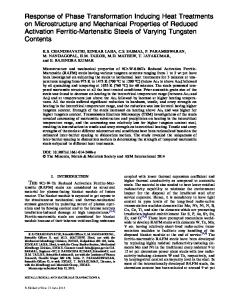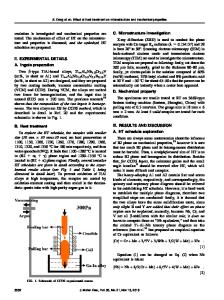Effect of Continuous Galvanizing Heat Treatments on the Microstructure and Mechanical Properties of High Al-Low Si Trans
- PDF / 1,427,133 Bytes
- 14 Pages / 593.972 x 792 pts Page_size
- 79 Downloads / 354 Views
TRODUCTION
MULTIPHASE low alloy transformation induced plasticity (TRIP)–assisted steels are ideal for lightweight automotive applications due to their combination of high strength while maintaining good ductility. These properties allow thinner cross sections to be used in structural applications, resulting in decreased vehicle weight, fuel consumption, and greenhouse gas emissions.[1] Furthermore, TRIP steels have excellent energy absorption capabilities, particularly at high strain rates, thereby improving passenger safety.[2,3] This combination of strength and ductility is brought about by the TRIP effect, composite strengthening provided by the multiphase microstructure, and solid solution strengthening provided by alloying additions such as C and Si.[4–8] Of particular importance is the TRIP effect, in which the transformation of high C content retained austenite to martensite occurs during plastic deformation.[9] The TRIP effect enhances the mechanical properties by two mechanisms: (1) composite strengthening via the formation of hard martensite particles dispersed in the ferrite matrix and (2) the formation of dislocations around newly formed martensite grains as a result of the E.M. BELLHOUSE, Doctoral Student, and J.R. McDERMID, Associate Professor, are with the McMaster Steel Research Centre, McMaster University, Hamilton, ON, Canada, L8S 4L7. Contact e-mail: [email protected] Manuscript submitted August 21, 2009. Article published online February 19, 2010 1460—VOLUME 41A, JUNE 2010
volumetric expansion occurring during the austenite to martensite transformation.[6,7] Optimal combinations of strength and ductility are obtained when the retained austenite stability is such that the transformation to martensite occurs gradually with increasing strain. A gradual transformation to martensite has been shown to be characterized by the instantaneous work hardening rate remaining high at high values of stress and strain, thereby delaying the onset of necking.[5] Corrosion protection is of prime importance in the automotive industry, and corrosion protection of TRIP steels must be provided in order to maintain the structural integrity and safety of the vehicle and to satisfy consumer demands for vehicle durability. Zinc coating via the continuous hot-dip galvanizing process is among the most cost effective solutions for achieving this objective. However, there are several challenges to be addressed when processing TRIP steels using the continuous galvanizing process. First, the heat treatments conventionally used to produce the desired TRIP steel multiphase microstructure are not necessarily compatible with the hot-dip galvanizing thermal cycle and can result in significant degradation of the desired properties.[10–12] Also, the selective oxidation of the alloying elements Mn, Al, and Si during annealing prior to galvanizing can result in poor reactive wetting and unacceptable bare spot defects in the Zn coating.[13–16] Si, in particular, was shown to be problematic for galvanizing.[13,15] Improved reactive wetting
Data Loading...











